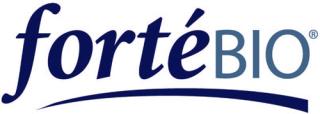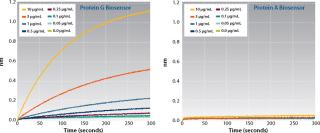Today’s antibodies are sourced from a diverse set of mammalian hosts whose isotypes have different affinities for protein A and protein G. ForteBio’s new protein G biosensor provides an “out-of-the-box” solution for direct quantitation of the mammalian immunoglobulins that do not bind to protein A. Readings can be performed in buffer, chromatography eluents, conditioned medium, and cultured lysates using a convenient 96- or 384- well microplate format. Assay parameters can be adjusted to detect concentrations from 0.05 µg/ml to 2,000 µg/mL, and the biosensor can be regenerated using a simple protocol. Turn around 96 samples in 15 minutes, 384 samples in one hour. No plate washing, no microfluidics, no liquid waste.
Key applications of the protein G biosensor: cell line development clone selection; upstream process development; chromatography mass balance; antibody affinity ranking; epitope mapping and binning; selection of ELISA antibody pairs.
Key features of the Octet system: direct, label-free, protein quantitation; fast turn-around in microplate format; real-time kinetic display; microfluidics free; liquid waste free; automation friendly.
The ForteBio octet system detects protein binding and dissociation events on the surface of a biosensor. Real-time monitoring provides kinetic data (kon, koff, KD) for protein– protein or protein–small-molecule interactions as well as protein concentration data. All experimental steps can be fully automated on the octet System in either a 96- or 384-well microplate format.
Available biosensor chemistries: protein G (new!); anti- HIS (new!); protein A; antihuman IgG Fc; antimurine IgG Fv; antihuman IgG Fc capture for kinetics; Streptavidin and Super Streptavidin for custom assays; amine reactive for custom assays; aminopropyl silane for custom assays
Author Details
Wesley Straub, PhD, is a product manager at ForteBio, Inc., 1360 Willow Road, Suite 201, Menlo Park, CA 94025; 1-650-289-6801, fax 1-650-322-1370; info@fortebio.com


